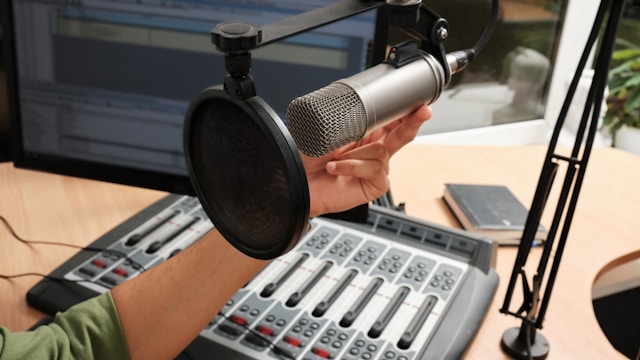
Audio journalism is having a renaissance at a time when public faith in legacy media hovers near historic lows. Gallup reports that overall, U.S. trust in mass media is at just 31 percent, yet separate studies show that listeners grant noticeably higher credibility to podcast hosts and radio presenters. In a 2024 national survey, 42 percent of Americans said they “trust or somewhat trust” information they hear on podcasts, 11 points above the level expressed for newspapers and television. This gap highlights audio’s core advantage: intimacy. When a human voice reaches a listener through earbuds or a smart speaker, it bypasses many visual cues that trigger skepticism, allowing tone, pacing, and authenticity to do most persuasion. Cognitive‑psychology research has long shown that voice‑only storytelling activates mental imagery and emotional centers differently than text or video, which partly explains why narrative podcasts such as Serial or The Daily can feel as riveting as binge‑worthy TV while requiring just a fraction of the production budget. For newsrooms, leaning into that natural bond offers a pathway to rebuild credibility in an era of information overload.
Personal Voices: The Secret Ingredient to Engagement
The Reuters Institute’s Digital News Report 2024 notes that news podcasts are one of the few formats still showing year‑over‑year audience growth while other digital products plateau. Listeners cite emotional connection with hosts as the top reason they keep returning. Whereas print bylines and on‑screen anchors maintain a professional distance, podcast hosts often reveal quirks, doubts, and even the occasional back‑of‑throat laugh. That self‑disclosure humanizes complex topics, whether explaining fiscal policy or narrating a conflict zone. It also provides a “parasocial” bridge—an illusion of friendship that keeps the app icon glowing red with fresh downloads. Pew Research finds half of U S. adults listened to at least one podcast last year, and nearly one‑fifth listen “nearly every day,” most often while multitasking. For publishers, that habitual companionship translates into extended time‑on‑brand: a 30‑minute episode plays start to finish far more frequently than a 1,200‑word article gets scrolled to the end.
Moreover, audio can spotlight under‑represented voices without the high‑gloss production values demanded by video. A phone, a quiet room, and basic editing software are enough for an investigative reporter in Dhaka or Detroit to deliver stories that resonate globally. The format’s low barrier to entry has sparked a flourishing of niche, identity‑driven journalism—from Indigenous affairs shows in Canada to bilingual immigration explainers in the U S.—creating communities that see (and hear) themselves reflected with respect.
Interactive Formats That Turn Listeners into Participants
Connection deepens when audiences do more than passively consume. The best audio journalists invite listeners behind the curtain through call‑ins, voice‑note submissions, and real‑time polls embedded in podcast apps. Times Radio in the U K. saw weekly listeners jump 12 percent during the 2024 general‑election period after branding itself “the election station” and soliciting audience questions that shaped on‑air interviews. Similarly, political campaigns in the United States have pivoted toward podcasts precisely because the medium lets candidates field unscripted queries while targeting micro‑demographics.
Interactive audio is not limited to politics. Non‑profit newsrooms use “reporting hotlines” to gather eyewitness accounts during natural disasters; investigative teams publish raw tape and invite crowdsourced transcription to expedite document digging; and local outlets integrate geofenced push notifications so that a resident walking past city hall can tap to hear a two‑minute explainer on today’s council vote. Each tactic turns the audience from consumer to collaborator, reinforcing that journalism is a shared civic project rather than a lecture from on high.
Strategies Newsrooms Can Use to Strengthen Listener Loyalty
Design for “micro‑moments”
Most podcast listening happens during commutes, chores, or workouts. Crafting 8‑ to 12‑minute bulletins—alongside longer narrative pieces—fills those micro‑windows and keeps the feed active without exhausting reporters.
Build identifiable sonic branding
A consistent intro jingle, segment stinger, and vocal signature help listeners recognize content instantly, even on smart‑speaker shuffle. This sonic logo functions like a visual masthead in the screen‑free environment.
Layer transcripts and show notes for SEO
Search bots can’t “hear,” so providing rich, keyword‑optimized transcripts ensures episodes rank for queries like audio journalism audience engagement long after publication. Annotated links in show notes satisfy accessibility guidelines and drive referral traffic back to the main site.
Use data dashboards intelligently
Podcast analytics lag behind web metrics, but completion rates, drop‑off points, and skip‑forward events offer actionable insight. Consider tightening the intro or moving sponsor reads if listeners consistently bail at minute seven.
Prioritize host credibility
The 2024 Podnews trust survey found that 56 percent of respondents were influenced by an ad purely because the host endorsed it. Transparent ad labeling and relevance to the editorial niche protect that trust. A climate‑news podcast, for instance, should think twice before accepting sponsorship from a petrochemical brand—even if the revenue looks attractive.
Explore multilingual and localized feeds
Global outlets like the BBC have launched city‑specific audio briefings, while independent creators release parallel Spanish or Bengali tracks. As voice‑cloning tools mature, newsrooms can experiment with AI‑assisted dubbing to scale without over‑stretching staff.
Integrate emerging tech carefully
Audiences are curious yet cautious about AI in news production. Disclosing when summaries or translations are machine‑generated—and offering a human‑edited version—demonstrates respect for listener agency.
Audio journalism’s power lies not simply in portability or convenience but in its capacity to forge genuine human bonds—one voice, one pair of earbuds at a time. At a moment when visual feeds feel frantic and institutional trust is fragile, sound offers a quieter, more contemplative lane where stories can breathe and audiences can feel seen. By blending authentic voices, interactive formats, and ethical data practices, newsrooms can transform listeners into loyal partners and, perhaps, begin rebuilding the public square on stronger acoustic foundations.